Overview
- Brief Narrative
- Silk hallah cover with a design painted by Poldek (Leopold) Schein in 1948 when he was living in Bergen-Belsen displaced persons camp. The cover is made from parachute silk and has an image of two golden lions holding a gold crown topped with a Star of David, with red flower clusters in each corner. The paints were sent to him by his uncle in the United States. Poland was invaded by Nazi Germany on September 1, 1939. Nineteen year old Poldek lived in Krakow with his parents Abraham and Mania, three brothers, Joseph, Herman, and Jacob, and two sisters Esther and Helena. Leopold, his father and his two older brothers left to enlist in the Polish Army. They traveled to Lwow, but soon after they arrived, the city surrendered to the Soviet Army. In 1940, Polish refugees were told they must become Soviet citizens. The Scheins refused and were sent to Kalchug, a forestry labor camp in Siberia. Abraham became ill and died that summer. In 1941, the three brothers, and other Polish refugees, were released from the camp and permitted to settle elsewhere in the Soviet Union. They went to Uzbekistan where they lived until the end of the war. Germany surrendered in May and that summer they left for Poland. They found almost no family members in Krakow. They decided to leave for Germany, and settled in the DP camp in Bergen-Belsen because they were told that it had a large Jewish community. Poldek worked painting houses, and eventually became head of graphics for the Jewish community. He married Pepi Levi, a survivor from Łódź, in December 1947. Joseph and Herman emigrated to Canada. A paternal uncle, Jacob Schein, in New York helped Poldek and Pepi get US immigration visas and they arrived in 1949. It was presumed that Leopold's mother, sisters, and youngest brother had been deported to Auschwitz and killed. In 1990, Leopold traveled to Poland and discovered that they had been shot by a guard on the train platform while waiting to be deported.
- Date
-
creation:
1948
- Geography
-
creation:
DP-Camp Bergen-Belsen;
Belsen (Bergen, Celle, Germany)
- Credit Line
- United States Holocaust Memorial Museum Collection, Gift of Leopold Schein
- Contributor
-
Artist:
Leopold Schein
Subject: Leopold Schein
- Biography
-
Poldek (Leopold) Schein was born on January 9, 1920, to Abraham and Mania (Maria) Gruenberg Schein in Facimiech, Poland, a small village near Krakow. Abraham was born in 1882. Maria was born in October 1887. Abraham owned a general store and sold tobacco and alcohol. Leopold had five siblings: Herman, born March 30, 1911; Jozek (Joseph), born May 21, 1913; Hela (Helena), born April 1918; Kubus (Jakob), born 1925; and Escia (Esther), born 1930. Abraham hired a yeshiva student to teach the children to read and write in Polish and Hebrew. Leopold learned to read and write very quickly, so when he was six years old, he was sent to live with an aunt in Krakow to attend a good school. He returned home after two years and attended school in the nearby town of Skawina for four years, living with his maternal uncle Leon Gruenberg during the school week and his parents during the weekend. Herman worked as a tailor and Joseph as a typesetter. In 1933, Leopold apprenticed to a barber. He wanted to be an artist and had an opportunity to apprentice to an advertising company but could not afford to pay the bond. In 1935, the family moved to Krakow because of growing anti-Semitism. In 1936, Leopold got a job working for a graphic artist. He also did freelance work making advertising labels for stores. In 1939, Leopold won a scholarship for art school. He was to begin on September 10, but on September 1, Poland was invaded by Nazi Germany.
When the war began, the Polish government called for all able bodied men to report for military service. Leopold, Abraham, Herman, and Joseph left to join the Polish army. Joseph traveled separately. They were on a train near the Bug River when it was hit by bombs. They stayed with a relative in Stanislawow (Ivano-Frankivsk, Ukraine), hoping to find Joseph. They continued on to Lwow (Lviv, Ukraine), where they were reunited with Joseph. Herman found a job as a tailor and secured an apartment. The Blanka Company for which Leopold had done freelance work had stores in Lwow and assisted people who had been associated with them. Blanka supplied Leopold with candies which he sold on the black market. This ended soon after September 22 when the Soviets took over the town per the German-Soviet pact and nationalized businesses. Leopold and Joseph found a job selling ice cream at a racetrack and Herman and Abraham worked as tailors. In 1940, the Soviets declared that people who had fled from German occupied Poland had to become Soviet citizens. Fearing that they would be unable to return home, the family went into hiding in summer 1940. After a week, Abraham and Herman were caught, so the others surrendered. They were kept in prison for a week then put in train cars with about 150 others. After three weeks, they arrived at Kalchug, a forestry labor camp in Siberia in the Arkhangelsk region. In fall 1940, Abraham and Herman became ill with dysentery. Leopold helped get them to a hospital, but Abraham died in October. Leopold and Joseph were allowed to leave camp for the funeral. A 1941 agreement allowed the Polish refugees to leave Siberia for other areas of the Soviet Union. The three brothers decided to join a group of 30 traveling to Tashkent, Uzbekistan. Leopold bartered his services as a barber for food. They went to another city hoping to work in the gold mines, but they could not get work permits. They moved to Kuvasoy, Uzbekistan. In June 1941, Germany attacked the USSR. The Soviets issued an amnesty that allowed Polish forced laborers, refugees, and prisoners to work in factories and agriculture to replace the Russians mobilized into the Red Army. An agreement was signed between the Polish Government in Exile and the Soviet government to form a Polish Army in the East. The brothers were told they had to join, but they were not accepted. Leopold again worked as a barber and became friendly with an engineer who helped him become a freelance artist. He needed an official job, and became the manager of the Red Corner, a local club, theater, and movie house. After a year, the brothers were again told they must become Soviet citizens. Leopold was hospitalized for jaundice and the Jewish doctor refused to let the Soviet officials talk to him.
Germany surrendered in the west on May 7 and in the east on May 9. Polish citizens were allowed to return home, but they had to prove they had lived in Poland before the war. Leopold worked forging illegal papers and made about 30 documents. He had a female friend without documents, so he married her, then divorced her after a month. Leopold, Herman, Herman’s wife Dressel, Joseph, and Joseph’s wife Hadassah, repatriated to Poland in late summer 1945. Hadassah went into labor while they were on the train, and Joseph and Hadassah had to get off to go to a hospital. In Krakow, Leopold and Herman were told they could not disembark but did so anyway. They reunited with Joseph, Hadassah, and their daughter. They heard that other family members had gone to Germany and left to find them in early 1946. When the family arrived in Germany, they were told they should go to Bergen-Belsen displaced persons camp since it had the largest Jewish community in the British zone of occupation. Leopold worked painting homes; Joseph and Herman also found jobs. Leopold met Pepi Levi, a survivor who was born on May 28, 1925, in Łódź, Poland, to Isaac and Helen Ciechanowski Levi. After her recovery from diptheria, they married on December 23, 1947 in a double wedding with her adopted sister Madelaine and Leopold’s best friend Romek Szmajuk. Leopold eventually became the head of graphics for the Jewish community in the camp. They wanted to go to Palestine but could not. They wrote to their paternal uncle Jacob in New York for help obtaining visas. In July 1948, Herman and Dressel emigrated to Canada where they were joined by Joseph and Hadassah in September. In June 1949, Leopold and Pepi left for the US on the General Ballou. They settled in New York and had two sons. Herman and Dressel relocated to New York. In 1990, Leopold returned to Poland to discover what had happened to his family. He went to Facimiech and met a man who said he had witnessed their deaths. His elder sister Helena, 24, was a forced laborer in a ceramic factory in Skawina. On August 29, 1942, Jews were ordered to report to the train station to be deported. Helena’s factory manager tried to convince her to leave her mother Maria, 55, brother Jacob, 17, and sister Esther, 12, but she refused. A soldier on the train platform heard their argument and shot them all. Pepi, age 58, died on January 22, 1984. Herman, age 88, died on February 1, 2000. Joseph, age 95, died on November 26, 2008.
Physical Details
- Language
- Hebrew
- Classification
-
Jewish Art and Symbolism
- Category
-
Jewish ceremonial objects
- Object Type
-
Hallah covers (aat)
- Genre/Form
- Ceremonial objects.
- Physical Description
- Square challah cover made from white parachute silk with a stiff, 1-inch, light blue painted border. A thin, wavy line of gold paint resembling stitching has been applied along the inner border where the painted band ends. Painted in the center are two golden male lions in profile, standing upright, and holding a golden crown with a Star of David between their front paws. The lion's, tongues extended, look backwards in opposite directions. Below them is a golden scroll with brown accents. There are two slightly arched lines of blue painted Hebrew text: one below the scroll and the other above the lions. In each corner is a triangular arrangement of red flowers, with yellow and pink accents, and green leaves. The text and flowers have raised outlines in iridescent paint. There is some slight staining.
- Dimensions
- overall: Height: 18.500 inches (46.99 cm) | Width: 18.000 inches (45.72 cm)
- Materials
- overall : silk, paint
- Inscription
- front, center, hand painted, gold paint : Hebrew text [Likhvod Shabat Kodesh Shenat Tav Shin Tet (In honor of Holy Shabbat / (The) Year [5]709 (which = 1949]
Rights & Restrictions
- Conditions on Access
- No restrictions on access
Keywords & Subjects
- Topical Term
- Holocaust, Jewish (1939-1945)--Poland--Krakow--Personal narratives. Jewish artists--Poland--Biography. Jewish refugees--Germany--Belsen (Bergen, Celle)--Biography. Jewish refugees--Soviet Union--Biography. Jewish refugees--United States--Biography. World War, 1939-1945--Refugees--Germany--Personal narratives. World War, 1939-1945--Prisoners and prisons, Soviet. Challah (Bread)
Administrative Notes
- Legal Status
- Permanent Collection
- Provenance
- The handpainted challah cover was donated to the United States Holocaust Memorial Museum in 2012 by Leopold Schein.
- Funding Note
- The cataloging of this artifact has been supported by a grant from the Conference on Jewish Material Claims Against Germany.
- Record last modified:
- 2023-04-11 14:59:20
- This page:
- https://collections.ushmm.org/search/catalog/irn96222
Download & Licensing
In-Person Research
- By Appointment
- Request 21 Days in Advance of Visit
- Plan a Research Visit
- Request to See This Object
Contact Us
Also in Leopold Schein collection
The collection consists of handpainted textiles, handmade notebook, correspondence, documents, photographs, and photograph albums relating to the experiences of Poldek (Leopold) Schein in prewar Poland, prior to his escape from Krakow to Soviet occupied Poland and his subsequent imprisonment in a Siberian labor camp and resettlement in Uzbekistan during the Holocaust, and to his life in Bergen-Belsen displaced persons camp in Germany and in the United States after the end of World War II.
Date: 1921-approximately 1956
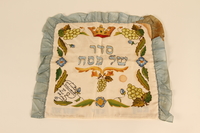
Silk matzah holder with a handpainted fruit and floral design for Passover created by a Jewish Polish refugee in Bergen-Belsen DP camp
Object
Silk matzoh holder with pockets and a hand painted harvest design painted by Poldek (Leopold) Schein in 1948, when he was living in Bergen-Belsen displaced persons camp. It is made from parachute silk as a gift for his uncle Jacob who sponsored his immigration. It has an inscription to "Our beloved aunt and uncle Pepi and Leib Schein Belzen 1948." The paints were sent to him by hin uncle from the United States. Poland was invaded by Nazi Germany on September 1, 1939. Nineteen year old Poldek lived in Krakow with his parents Abraham and Mania, three brothers, Joseph, Herman, and Jacob, and two sisters Esther and Helena. Poldek, his father, and his two older brothers left to enlist in the Polish Army. They traveled to Lwow, but soon after they arrived, the city surrendered to the Soviet Army. In 1940, Polish refugees were told they must become Soviet citizens. The Scheins refused and were sent to Kalchug, a forestry labor camp in Siberia. Abraham became ill and died that summer. In 1941, the three brothers, and other Polish refugees, were released from the camp and permitted to settle elsewhere in the Soviet Union. They went to Uzbekistan where they lived until the end of the war. Germany surrendered in May and that summer they left for Poland. They found almost no family members in Krakow. They decided to leave for Germany, and settled in the DP camp in Bergen-Belsen because they were told that it had a large Jewish community. Leopold worked painting houses, and eventually became head of graphics for the Jewish community. He married Pepi Levi, a survivor from Łódź, in December 1947. Joseph and Herman emigrated to Canada. A paternal uncle, Jacob Schein, in New York helped Poldek and Pepi get US immigration visas and they arrived in 1949. It was presumed that Leopold's mother, sisters, and youngest brother had been deported to Auschwitz and killed. In 1990, Leopold traveled to Poland and discovered that they had been shot by a guard on the train platform while waiting to be deported.
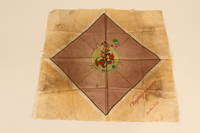
Silk scarf with a handpainted clown and an inscription created by a Jewish Polish refugee in Bergen-Belsen DP camp
Object
Silk scarf with a design painted by Poldek (Leopold) Schein for his future wife Pepi on November 14, 1946, when he was living in Bergen-Belsen displaced persons camp. The scarf features a jack-in-the-box jester with a book and best wishes from Poldek and his best friend Romek. On December 25, 1947, Pepi and Poldek had a double wedding with Romek and Pepi's adopted sister Madelaine. Romek died of a hernia in the DP camp in 1949. Poland was invaded by Nazi Germany on September 1, 1939. Nineteen year old Poldek lived in Krakow with his parents Abraham and Mania, three brothers, Joseph, Herman, and Jacob, and two sisters Esther and Helena. Poldek, his father and his two older brothers left to enlist in the Polish Army. They traveled to Lwow, but soon after they arrived, the city surrendered to the Soviet Army. In 1940, Polish refugees were told they must become Soviet citizens. The Scheins refused and were sent to Kalchug, a forestry labor camp in Siberia. Abraham became ill and died that summer. In 1941, the three brothers, and other Polish refugees, were released from the camp and permitted to settle elsewhere in the Soviet Union. They went to Uzbekistan where they lived until the end of the war. Germany surrendered in May and that summer they left for Poland. They found almost no family members in Krakow. They decided to leave for Germany, and settled in the DP camp in Bergen-Belsen because they were told that it had a large Jewish community. Poldek worked painting houses, and eventually became head of graphics for the Jewish community. He married Pepi Levi, a survivor from Łódź, in December 1947. Joseph and Herman emigrated to Canada. A paternal uncle, Jacob Schein, in New York helped Poldek and Pepi get US immigration visas and they arrived in 1949. It was presumed that Leopold's mother, sisters, and youngest brother had been deported to Auschwitz and killed. In 1990, Leopold traveled to Poland and discovered that they had been shot by a guard on the train platform while waiting to be deported.
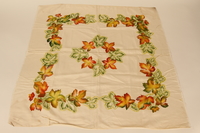
Tablecloth with a handpainted maple leaf design created by a Jewish Polish refugee in Bergen-Belsen DP camp
Object
White tablecloth made from parachute silk with a maple leaf border painted by Poldek (Leopold) Schein around 1948 when he was living in Bergen-Belsen displaced persons camp. The paints were sent to him by his uncle in the United States. Poland was invaded by Nazi Germany on September 1, 1939. Nineteen year old Poldek lived in Krakow with his parents Abraham and Mania, three brothers, Joseph, Herman, and Jacob, and two sisters Esther and Helena. Poldek, his father and his two older brothers left to enlist in the Polish Army. They traveled to Lwow, but soon after they arrived, the city surrendered to the Soviet Army. In 1940, Polish refugees were told they must become Soviet citizens. The Scheins refused and were sent to Kalchug, a forestry labor camp in Siberia. Abraham became ill and died that summer. In 1941, the three brothers, and other Polish refugees, were released from the camp and permitted to settle elsewhere in the Soviet Union. They went to Uzbekistan where they lived until the end of the war. Germany surrendered in May and that summer they left for Poland. They found almost no family members in Krakow. They decided to leave for Germany, and settled in the DP camp in Bergen-Belsen because they were told that it had a large Jewish community. Poldek worked painting houses, and eventually became head of graphics for the Jewish community. He married Pepi Levi, a survivor from Łódź, in December 1947. Joseph and Herman emigrated to Canada. A paternal uncle, Jacob Schein, in New York helped Poldek and Pepi get US immigration visas and they arrived in 1949. It was presumed that Leopold's mother, sisters, and youngest brother had been deported to Auschwitz and killed. In 1990, Leopold traveled to Poland and discovered that they had been shot by a guard on the train platform while waiting to be deported.
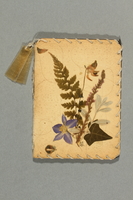
Notebook with pressed flower cover
Object
Handmade notebook from the collection relating to to the experiences of Poldek (Leopold) Schein in prewar Poland, prior to his escape from Krakow to Soviet occupied Poland and his subsequent imprisonment in a Siberian labor camp and resettlement in Uzbekistan during the Holocaust, and to his life in Bergen-Belsen displaced persons camp in Germany and in the United States after the end of World War II.
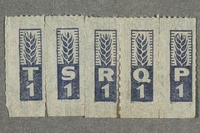
Ration coupons
Object
Ration coupons from the collection relating to to the experiences of Poldek (Leopold) Schein in prewar Poland, prior to his escape from Krakow to Soviet occupied Poland and his subsequent imprisonment in a Siberian labor camp and resettlement in Uzbekistan during the Holocaust, and to his life in Bergen-Belsen displaced persons camp in Germany and in the United States after the end of World War II.
Leopold Schein papers
Document
Photographs, albums, and correspondence documenting Leopold Schein's experiences during the Holocaust. Collection includes album of family photographs, a wedding album from Harzburg/Bergen-Belsen displaced persons camp, family autograph book commemorating the 1926 visit of American uncle Jack Schein to Krakow, documents for Leopold Schein, a "Familien Stammbuch" issued to Leopold Schein in 1949 in Celle, documents from the Bergen Belsen displaced persons camp and assorted family photographs.



